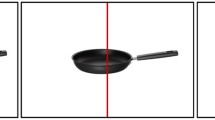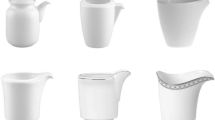Abstract
It has been proposed that grasping affordances produce a Simon-type correspondence effect for left–right keypress responses and the location of the graspable part of an object for judgments based on action-relevant properties such as shape, but not on surface properties. We tested the implications of this grasping affordance account and contrasted them with the ones derived from a spatial coding account that distinguishes holistic processing of integral dimensions and analytic processing of separable dimensions. In Experiments 1–3, judgments about the color of a door handle showed a Simon effect relative to the handle’s base, whereas judgments about the handle’s shape showed no Simon effect. In Experiment 4, when the middle of the handle was colored, the Simon effect was obtained relative to the base, but when the color was at the tip of the handle or near the base, Simon effects were obtained relative to the color location. For Experiment 5, only the base was colored, and the Simon effect was larger for a passive rather than active handle state, as in the color-judgment conditions of Experiments 2–4 in which the colored region overlapped with the base. In Experiment 6, orientation judgments showed no Simon effect, as the shape judgments did in Experiments 1 and 2. The findings of (a) an absence of Simon effects for shape and orientation judgments, (b) no larger Simon effects for active than passive handle states, and (c) isolation of the changing component for color judgments are consistent with the spatial coding account, according to which the distinction between object shape/orientation and color is one of integral versus separable dimensions.





Similar content being viewed by others
Notes
The number of participants was doubled in this experiment. because subsequent experiments were designed based on the results of Experiment 2. Thus, the experiment was conducted originally with 40 participants, and then a replication was conducted with an additional 40 participants to ensure that the main results were reliable. The resulting RT data were analyzed in a single ANOVA of trial block (first half of trial blocks, second half) × state of handle (active, passive) × correspondence (corresponding, noncorresponding) × experiment (original, replication) × condition (color, shape). For this analysis, the only significant term involving experiment was the four-way interaction of trial block × correspondence × condition × experiment, F(1, 76) = 8.10, p = .006, η 2 p = .10. This interaction was due mainly to a somewhat different pattern of results across the two trial blocks for the shape-judgment condition in the two experiments. Because the main results were consistent across the replications, we report the combined data of the 80 participants for Experiment 2.
References
Anzola, G. P., Bertoloni, G. G., Buchtel, H. A., & Rizzolatti, G. G. (1977). Spatial compatibility and anatomical factors in simple and choice reaction time. Neuropsychologia, 15, 295–302.
Borghi, A. M., Bonfiglioli, C., Lugli, L., Ricciardelli, P., Rubichi, S., & Nicoletti, R. (2007). Are visual stimuli sufficient to evoke motor information? Studies with hand primes. Neuroscience Letters, 411, 17–21.
Bub, D. N., & Masson, M. E. J. (2010). Grasping beer mugs: On the dynamics of alignment effects induced by handled objects. Journal of Experimental Psychology: Human Perception and Performance, 36, 341–358.
Cant, J. S., & Goodale, M. A. (2009). Asymmetric interference between the perception of shape and the perception of surface properties. Journal of Vision, 9, 1–20.
Cant, J. S., & Goodale, M. A. (2011). Scratching beneath the surface: New insights into the functional properties of the lateral occipital area and parahippocampal place area. Journal of Neuroscience, 31, 8248–8258.
Cant, J. S., Large, M. E., McCall, L., & Goodale, M. A. (2008). Independent processing of form, colour, and texture in object perception. Perception, 37, 57–78.
Cho, Y. S., Choi, J. M., & Proctor, R. W. (2011). Likelihood of attending to the color word modulates Stroop interference. Attention, Perception, & Psychophysics, 74, 416–429.
Cho, D. (T.), & Proctor, R. W. (2010). The object-based Simon effect: Grasping affordance or relative location of the graspable part? Journal of Experimental Psychology: Human Perception and Performance, 36, 853–861.
Cho, D. (T.), & Proctor, R. W. (2011). Correspondence effects for objects with opposing left and right protrusions. Journal of Experimental Psychology: Human Perception and Performance, 37, 737–749.
De Jong, R., Liang, C–. C., & Lauber, E. (1994). Conditional and unconditional automaticity: A dual-process model of effects of spatial stimulus–response correspondence. Journal of Experimental Psychology: Human Perception and Performance, 20, 731–750.
Derbyshire, N., Ellis, R., & Tucker, M. (2006). The potentiation of two components of the reach-to-grasp action during object categorisation in visual memory. Acta Psychologica, 122, 74–98.
Dick, M., & Hochstein, S. (1988). Interactions in the discrimination and absolute judgment of orientation and length. Perception, 17, 177–189.
Dykes, J. R., & Cooper, R. G. (1978). An investigation of the perceptual basis of redundancy gain and orthogonal interference for integral dimensions. Perception & Psychophysics, 23, 36–42.
Ellis, R., & Tucker, M. (2000). Micro-affordance: The potentiation of components of action by seen objects. British Journal of Psychology, 91, 451–471.
Felfoldy, G. L. (1974). Repetition effects in choice reaction time to multidimensional stimuli. Perception and Psychophysics, 15, 453–459.
Fitts, P. M., & Deininger, R. L. (1954). S–R compatibility: Correspondence among paired elements within stimulus and response codes. Journal of Experimental Psychology, 48, 483–492.
Galpin, A., Tipper, S. P., Dick, J. P. R., & Poliakoff, E. (2011). Object affordance and spatial compatibility effects in Parkinson’s disease. Cortex, 47, 332–341.
Ganel, T., & Goodale, M. A. (2003). Visual control of action but not perception requires analytical processing of object shape. Nature, 426, 664–667.
Garner, W. R. (1974). The processing of information and structure. Potomac, MD: Erlbaum.
Geyer, T., & Müller, H. J. (2009). Distinct, but top-down modulable color and positional priming mechanisms in visual pop-out search. Psychological Research/Psychologische Forschung, 73, 167–176.
Gibson, J. J. (1979). The ecological approach to visual perception. Boston: Houghton Mifflin.
Hommel, B. (2011). The Simon effect as tool and heuristic. Acta Psychologica, 136, 189–202.
Iani, C., Baroni, G., Pellicano, A., & Nicoletti, R. (2011). On the relationship between affordance and Simon effects: Are the effects really independent? Journal of Cognitive Psychology, 23, 121–131.
Kornblum, S., Hasbroucq, T., & Osman, A. (1990). Dimensional overlap: Cognitive basis for stimulus–response compatibility: A model and taxonomy. Psychological Review, 97, 253–270.
Loach, D., Frischen, A., Bruce, N., & Tsotsos, J. (2008). An attentional mechanism for selecting appropriate actions afforded by graspable objects. Psychological Science, 19, 1253–1257.
Lu, C. –. H., & Proctor, R. W. (1995). The influence of irrelevant location information on performance: A review of the Simon and spatial Stroop effects. Psychonomic Bulletin & Review, 2, 174–207.
Macmillan, N. A., & Ornstein, A. S. (1998). The mean-integral representation of rectangles. Perception & Psychophysics, 60, 250–262.
Maetens, K., Henderickx, D., & Soetens, E. (2009). Binding of event files in a (go/no-go) Simon task with an accessory peripheral signal. Experimental Psychology, 56, 100–111.
Memelink, J., & Hommel, B. (2012). Intentional weighting: a basic principle in cognitive control. Psychological Research/Psychologische Forschung. doi:10.1007/s00426-012-0435-y
Nicoletti, R., Anzola, G. P., Luppino, G., Rizzolatti, G., & Umiltà, C. (1982). Spatial compatibility effects on the same side of body midline. Journal of Experimental Psychology: Human Perception and Performance, 8, 664–673.
Pellicano, A., Iani, C., Borghi, A. M., Rubichi, S., & Nicoletti, R. (2010). Simon-like and functional affordance effects with tools: The effects of object perceptual discrimination and object action state. Quarterly Journal of Experimental Psychology, 63, 2190–2201.
Phillips, J. C., & Ward, R. (2002). S–R correspondence effects of irrelevant visual affordance: Time course and specificity of response activation. Visual Cognition, 9, 540–548.
Proctor, R. W., Miles, J. D., & Baroni, G. (2011). Reaction time distribution analysis of spatial correspondence effects. Psychonomic Bulletin & Review, 18, 242–266.
Proctor, R. W., Pick, D. F., Vu, K.-P. L., & Anderson, R. E. (2005). The enhanced Simon effect for older adults is reduced when the irrelevant location information is conveyed by an accessory stimulus. Acta Psychologica, 119, 21–40.
Proctor, R. W., & Reeve, T. G. (1990). Research on stimulus–response compatibility: Toward a comprehensive account. In R. W. Proctor & T. G. Reeve (Eds.), Stimulus–response compatibility: An integrated perspective (pp. 483–494). Amsterdam: North-Holland.
Riggio, L., Iani, C., Gherri, E., Benatti, F., Rubichi, S., & Nicoletti, R. (2008). The role of attention in the occurrence of the affordance effect. Acta Psychologica, 127, 449–458.
Rubichi, S., Iani, C., Nicoletti, R., & Umiltà, C. (1997). The Simon effect occurs relative to the direction of an attention shift. Journal of Experimental Psychology: Human Perception and Performance, 23, 1353–1364.
Sanders, A. F. (1998). Elements of human performance: Reaction processes and attention in human skill. Mahwah, NJ: Lawrence Erlbaum.
Simon, J. R. (1990). The effects of an irrelevant directional cue on human information processing. In R. W. Proctor & T. G. Reeve (Eds.), Stimulus-response compatibility. An integrated perspective (pp. 31-86). Amsterdam: North-Holland.
Simon, J. R., Craft, J. L., & Webster, J. B. (1973). Reactions toward the stimulus source: Analysis of correct responses and errors over a five-day period. Journal of Experimental Psychology, 101, 175–178.
Tipper, S. P., Paul, M. A., & Hayes, A. E. (2006). Vision for action: the effects of object property discrimination and action state on affordance Simon effects. Psychonomic Bulletin & Review, 13, 493–498.
Tucker, M., & Ellis, R. (1998). On the relations between seen objects and components of potential actions. Journal of Experimental Psychology: Human Perception and Performance, 24, 830–846.
Tucker, M., & Ellis, R. (2001). The potentiation of grasp types during visual object categorization. Visual Cognition, 8, 769–800.
Umiltà, C., & Nicoletti, R. (1990). Spatial stimulus–response compatibility. In R. W. Proctor & T. G. Reeve (Eds.), Stimulus–response compatibility: An integrated perspective (pp. 89–116). Amsterdam: North-Holland.
Vainio, L., Symes, E., Ellis, R., Tucker, M., & Ottoboni, G. (2008). On the relations between action planning, object identification, and motor representations of observed actions and objects. Cognition, 108, 444–465.
Yamaguchi, M., & Proctor, R. W. (2012). Multidimensional vector model of stimulus–response compatibility. Psychological Review, 119, 272–303.
Zhang, J., & Kornblum, S. (1997). Distributional analysis and De Jong and Liang and Lauber’s (1994) dual-process model of the Simon effect. Journal of Experimental Psychology: Human Perception and Performance, 23, 1543–1551.
Acknowledgments
We thank S. P. Tipper and M. A. Paul for providing us with the stimulus files that they used in their 2006 study with A. E. Hayes.
Author information
Authors and Affiliations
Corresponding author
Rights and permissions
About this article
Cite this article
Cho, D.T., Proctor, R.W. Object-based correspondence effects for action-relevant and surface-property judgments with keypress responses: evidence for a basis in spatial coding. Psychological Research 77, 618–636 (2013). https://doi.org/10.1007/s00426-012-0458-4
Received:
Accepted:
Published:
Issue Date:
DOI: https://doi.org/10.1007/s00426-012-0458-4




